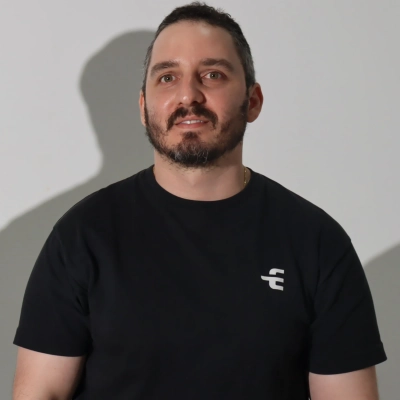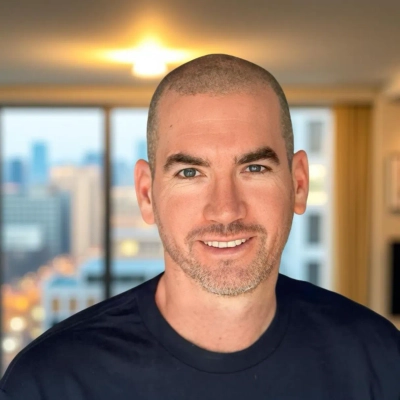25 Ways to Identify Your Most Profitable Customer Segment in Your Small Business
Discovering which customer segments drive the most profit can transform a small business from surviving to thriving, as leading market analysts and business strategists confirm. This practical guide offers 25 actionable strategies to identify your most valuable customers, helping you allocate resources more effectively and boost your bottom line. Experts in customer segmentation, data analysis, and small business growth have contributed their proven methods that work across industries and business models.
Revisit Job Descriptions for Accurate Pay Equity
We identified our most profitable segment not by average ticket size, but by customer acquisition cost (CAC) and margin. We run separate campaigns by segment and track CAC tightly. In our case, we compare limited liability vs full coverage policies.
Full coverage has a much bigger ticket, about 5x higher than limited liability, but the CAC is also higher because the quoting/underwriting process is more complex. For several campaigns, limited liability policies delivered lower CAC and therefore higher margins, despite the smaller ticket.
That insight shifted our spend and creative: we prioritize segments where CAC-to-margin is healthiest, not just where revenue per sale looks large on paper.

Balance Revenue with Resource Allocation Efficiency
In my business, which revolves around public relations and media placement, I have identified my most profitable customer segments by looking beyond just revenue and focusing on efficiency. I ask myself questions like, 'What is the cost to serve this client?' How much of my team's time will it require? And how many resources will be tied up? Profitability isn't solely about the retainer; it's about balancing revenue with resource allocation.
I also explore how I can deliver impact at scale by incorporating automation into our processes. For instance, automating parts of reporting or outreach frees up bandwidth, enabling us to serve more clients effectively without increasing overhead. The key data points I track include client lifetime value, average time spent per account, and the frequency with which we can replicate results with minimal manual effort.
What I've discovered is that my most profitable customers are those whose needs align with the systems and automations I've already built. They value strategy, trust the process, and don't require constant hand-holding. That's where the business experiences both strong margins and sustainable growth.
My most profitable customers aren't always the biggest accounts; they're the ones where impact meets efficiency, and where automation allows us to deliver at scale.

Target Mid-sized Businesses for Optimal Profits
We discovered our most profitable segment by analyzing customer lifetime value against service complexity rather than just revenue size. The data revealed that mid-sized service businesses (10-50 employees) with existing websites generated 3x more profit than larger clients or startups. They had clear growth goals, existing customer bases to optimize for, and decision-making authority. This insight came from tracking project scope creep, support ticket volume, and payment terms across client types. Now we prioritize this segment in our marketing, resulting in 60% higher profit margins.
Find Clients That Match Your Strengths
Initially, we defined profitability purely by revenue figures. But operational strain soon forced a deeper review. Certain clients consumed disproportionate resources with little sustainable payoff. Others grew seamlessly alongside our systems, producing compounding returns naturally.
When I looked closely, SaaS and e-commerce clients rose consistently. Their scalability and alignment with digital-first services matched our strengths. That synergy reduced inefficiencies while maximizing long-term outcomes. Profitability became about fit, not simply fees, teaching me to choose deliberately.
Measure Business Impact Not Just Traffic
The real turning point at our company came when we shifted our focus from measuring traffic to measuring business impact. Having a large readership was valuable but the real insight came from seeing which users viewed our platform as a trusted growth partner. We noticed that vendors consistently invested in visibility and that their engagement often developed into profitable partnerships. This helped us understand that the true value was in audience size and how businesses actively connected with the platform to grow.
We carefully studied data such as directory searches, campaign renewals and article performance. These insights showed us that companies were not just reading content but using the ecosystem as a tool for measurable business growth. Once we identified these companies as our most profitable segment we focused on creating scalable solutions. Lead generation tools became central allowing vendors to achieve real results while we built a sustainable revenue model.
Analyze Beyond Revenue to Find True Value
In my small business, I identified our most profitable customer segment through a combination of financial analysis and behavioral insights. Rather than focusing solely on revenue, I analyzed profitability by considering acquisition costs, retention rates, and lifetime value.
Initially, all customers appeared similar in value, but after examining marketing spend, service time, and churn data, clear patterns emerged. Some customers were significantly more expensive to acquire and maintain, while others engaged consistently, referred new clients, and required less support.
Several key data points revealed our most profitable segment:
First, tracking acquisition channels showed that referrals and organic leads had substantially lower costs than paid advertising. Referral-based customers typically stayed longer and cost almost nothing to acquire compared to those from digital ads.
Second, lifetime value calculations revealed that repeat buyers in a specific age and income bracket generated 3-4 times more revenue than one-time purchasers, indicating where to focus for growth.
Third, transaction data highlighted a segment that consistently purchased premium products or bundled services, both spending more per transaction and buying more frequently.
Fourth, customer service records showed that while some segments generated solid revenue, their extensive support needs reduced actual profitability.
Finally, engagement metrics from surveys and our CRM system identified which customers regularly opened newsletters, attended webinars, and used loyalty perks - behaviors strongly correlated with retention and long-term profitability.
By integrating these insights, I discovered our most profitable segment wasn't necessarily our largest - it was engaged, repeat customers who came through referrals and consistently chose premium offerings. Once identified, I strengthened referral incentives, customized marketing approaches, and created exclusive loyalty benefits for this group.
The results were significant: improved marketing ROI by avoiding low-value leads and increased overall profitability by nurturing relationships with customers bringing the greatest long-term value.

Segment Clients Based on Project History
We identified our most profitable customer segment by applying data analytics to our client base of over 500 businesses. Instead of waiting for clients to reach out with new projects, we analyzed three key factors: total spending, recency of their last project, and the number of projects completed with us.
Based on this, we segmented our clients into four categories:
A-clients: Those who had completed three or more projects with us within the past year. We engaged them proactively, introducing new technologies we work with and suggesting additional features we could develop.
B-clients: Those who had worked with us more than once but had since lost contact. Our goal was to reconnect with them and nurture them into A-clients.
C-clients: Those who had only completed a single project with us. We implemented regular follow-ups to encourage them to become B-clients.
D-clients: Those we decided not to pursue further. Our account management team was instructed to exclude them from outreach efforts.
As a result of this approach, our weekly sales doubled within the first four weeks of implementation.

Look for Partners, Not Just Paying Clients
In the early days of Nerdigital, I fell into the trap of thinking "any paying client is a good client." We worked with businesses across industries—local shops, startups, eCommerce brands, even a few nonprofits. On paper, it looked like growth. But behind the scenes, I started noticing that not all clients contributed equally to our sustainability. Some accounts drained more resources than they brought in, while others quietly carried the business forward.
The turning point came when I decided to dig deeper into our client data rather than rely on surface-level revenue numbers. I pulled reports on project profitability, average retainer size, churn rate, and even how many hours our team spent servicing each account. The insights were eye-opening. For example, a small SaaS company paying us less on paper turned out to be far more profitable than a larger corporate client. Why? They had faster approval processes, valued our expertise, and required less hand-holding—allowing us to deliver great results without excessive overhead.
I also started paying attention to softer data—things like client responsiveness, openness to experimentation, and long-term growth potential. Over time, I realized that our most profitable customer segment wasn't defined by size or budget, but by mindset. Growth-oriented companies that treated us like partners, not vendors, consistently drove the healthiest margins and the most fulfilling work.
That discovery reshaped how we approached sales and marketing. Instead of chasing "big logos," we doubled down on identifying businesses that aligned with that profile. The result was higher retention, stronger referrals, and more predictable revenue.
The lesson for me was simple: profitability isn't just about revenue—it's about the relationship between effort, efficiency, and growth potential. By looking at both hard data and human behavior, we found the segment that truly fit us.

Calculate Effective Hourly Rates Across Clients
The turning point came when I calculated effective hourly rates across clients. Some industries required endless revisions and handholding. Others respected boundaries and collaborated productively, maximizing efficiency naturally. Profitability correlated strongly with how clients valued our expertise internally.
I realized e-commerce brands valued agility without excessive back-and-forth. They appreciated results over unnecessary perfectionism, which accelerated campaign turnaround. That dynamic translated into healthier margins and long-term scalability. It proved that profitable segments respect partnership balance rather than commoditizing services.

Track Engagement Patterns Beyond Casual Interactions
Profitability often hides behind patterns that are easy to overlook. We discovered this when comparing casual readers with those who actively sought advanced learning insights. The latter group returned regularly, consumed more content and engaged with peers consistently. Their higher engagement prompted us to track conversions more carefully and observe trends in their behavior.
By aligning qualitative signals with quantitative outcomes, we noticed that this smaller yet highly dedicated segment generated stronger results. This insight revealed that our most profitable customers viewed learning as a continuous journey rather than a one-time resource. Understanding this allowed us to focus on nurturing long-term engagement and tailoring experiences that maximize value for both the learners and the business.

Focus on Customer Lifetime Value Metrics
Something that really helped us here was looking at customer lifetime value. This particular KPI is something we've tracked from the beginning, and it's one that we put a big emphasis on. By looking at it among our various customer segments, it helped us see which specific segment would be the most valuable for us not just now but over time.
Monitor Both Sales Data and Referrals
We identified our most profitable customer segment by looking closely at both sales data and the types of projects that brought long-term value. At first, we served a wide range of customers, but when we started analyzing which projects had the highest margins and repeat business, a pattern emerged. It was the clients who valued customized, high-quality window coverings, often homeowners investing in whole-home upgrades or interior designers sourcing for their clients.
The key insight came from tracking not just the initial sale, but the follow-up orders and referrals. These customers were less price-sensitive and more focused on quality and design. They also tended to share their positive experiences with others, which created a ripple effect in new business. We paired that with website and lead form data, noticing that inquiries mentioning words like "custom," "luxury," or "design consultation" had a much higher close rate.
By aligning our marketing and showroom experience around that segment, we were able to focus on the work that was both most rewarding and most profitable for our business.

Connect Product Choice With Daily Wellness Routines
Our approach was guided by curiosity to understand why some customers returned more often. We discovered that those who made our products part of their daily wellness routines created the most consistent value. This pattern showed us that the connection between routine and product choice played a key role in building steady engagement. The insights gave us a clear view of how meaningful habits influence loyalty and helped us see which products carried the strongest appeal.
The data supported what our customers told us directly. They valued authenticity in our ingredients, eco-friendly packaging and the deep link between our land and their skincare experience. Their loyalty appeared not only in their repeated purchases but also in the way they spoke about us to others. This mix of trust, consistency and recommendations turned into our most profitable segment. It reminded us that shared values and genuine connection drive long-term success.

Identify Customers Seeking Long-Term Solutions
We found our most profitable segment not by looking at demographics, but by analyzing the specific skin problem a customer was trying to solve. Early on, we tracked broad metrics like Average Order Value, but that was misleading. Our data showed that customers buying products to address chronic conditions like eczema or rosacea had a much higher repeat purchase rate and lifetime value, even if their first order wasn't the largest. They weren't just buying a product, they were seeking a long-term solution.
The key insight came from cohort analysis in our Shopify data, which we compared against our Amazon sales patterns. We tracked customers based on their first purchase and then monitored their subsequent buying behavior over 12 months. This revealed that the LTV to CAC ratio was dramatically better for the problem-solver segment. It confirmed that focusing our marketing on providing genuine relief creates far more sustainable value than chasing transactional, one-off sales.

Combine Demographics With Purchase Behavior Analysis
To identify the most profitable customer segment in my small business, I took a data-driven approach by analyzing both customer behavior and financial performance. Here's how I did it:
1. Segmentation by Demographics and Behavior: I began by segmenting my customer base based on key demographics (e.g., age, location, income level) and behavior patterns (e.g., purchase frequency, average transaction size). I used tools like Google Analytics and customer relationship management (CRM) software to track these variables.
2. Tracking Lifetime Value (LTV): I calculated the lifetime value of each customer segment to understand which groups were contributing the most over time, not just for one-time purchases. I looked at repeat purchase rates, referral behaviors, and overall spending.
3. Profit Margins and Conversion Rates: I also examined the profit margins of the products or services each segment was purchasing. Some segments may have generated high sales volume, but low margins, while others may have been smaller but more profitable due to higher-value purchases or lower costs.
4. Customer Feedback and Surveys: I regularly collected customer feedback through surveys and direct interactions, asking questions about satisfaction, preferences, and potential pain points. This helped identify which segments were most loyal and likely to continue doing business long-term.
5. Data Insights: Through this analysis, I discovered that one segment—mid to high-income professionals in urban areas—was consistently generating the highest profit, with higher purchase frequency, larger transactions, and better retention. These customers also referred others, indicating high satisfaction.
This discovery allowed me to double down on targeted marketing strategies aimed at this segment, adjusting my product offerings and marketing messages to better resonate with their specific needs, leading to increased profitability and growth.

Compare Lifetime Value Against Acquisition Cost
We found our most profitable segment by looking at lifetime value against acquisition cost. Transaction data showed bulk buyers had lower churn and higher repeat orders than individual shoppers. When we overlaid support costs, the margin gap was even clearer. That insight came from combining sales data with retention metrics, not just top-line revenue.

Find Customers With Best Value-to-Effort Ratio
The most profitable customers are usually the ones who make your business feel steady without making it complicated. To find them, you need to look beyond just who buys the most and pay attention to patterns over time. Track who comes back regularly, who spends without hesitation, and who engages with your business. These signals often reveal the customers who are quietly driving the real profit.
Another insight comes from considering costs. Some clients spend a lot but take up endless time or resources, while others make modest purchases but are easy to serve and consistently return. When you combine frequency, spend, and effort required, the picture becomes clear. Look for the group where the ratio of value to effort is highest. Once identified, you can focus marketing, tailor products, and communicate in ways that speak directly to them.
Study Competitors to Discover Customer Segments
At the very start of my business, one of the first things we did was analyze our competitors. We knew that doing this would give us the best baseline idea about who our customers would be according to who their customers were. We were able to figure out their biggest customer segment pretty easily and essentially adopted that as our own, and then as time went on and we did more and more customer analysis, we discovered that that segment was in fact going to be our most profitable one.
Tailor Services to Community Needs
Identifying our most profitable customer segment at ALP Heating LTD. was an insightful journey that involved both data analysis and a deep understanding of our community's unique needs. As the CEO and founder, I've always believed that our growth hinges on not just the services we offer but also on truly knowing our clients-residential and business alike.
Initially, we gathered data from various sources, including customer feedback, service requests, and maintenance plan enrollments. This allowed us to identify patterns in our customer base, particularly in the Greater Toronto Area, where climate challenges can vary widely. For instance, we noted that families in Maple and Newmarket tend to prioritize energy-efficient solutions, especially during extreme weather months. This insight helped us tailor our offerings to meet their specific needs, such as promoting our ALPCare preventive maintenance plans, which not only enhance system efficiency but also provide peace of mind for homeowners.
Additionally, we utilized analytics tools to track which services generated the most repeat business and referrals. For example, our furnace installation and repair services consistently showed high customer satisfaction ratings, leading us to focus more on these areas. We recognized that homeowners who invested in energy-efficient furnaces not only appreciated the immediate comfort but also valued long-term energy savings-making them a key segment for us.
Moreover, our commitment to safety and reliability played a significant role in attracting business clients. Many local businesses rely on HVAC systems to maintain a comfortable environment for their employees and customers. By emphasizing our fully licensed, TSSA-certified technicians and our quick response times, we positioned ourselves as a trusted partner for these companies.
In essence, the combination of data insights and a customer-focused approach allowed us to identify and nurture our most profitable segments effectively. As we grow, we continue to listen closely to our clients' needs and adapt our services accordingly. This adaptability, coupled with our dedication to community-oriented service, is what sets ALP Heating apart in the HVAC industry. It's not just about heating and cooling; it's about creating lasting relationships with our customers and ensuring their comfort year-round.

Let Numbers Tell Your Profitability Story
The truth is that finding out that clients interested in luxury interior design services were my most profitable customer segment was pretty simple, and not because I have been an interior designer for much longer than I have been an investor, or because over the years I have gotten more interior design projects done. I know this because the numbers tell the story and provide evidence of the areas of my business that bring in the most money.
One specific data that led to this discovery is my average revenue per project for luxury interior design clients. You see, while it can be a whole lot easier to jump to the conclusion the luxury interior design generates the most revenue for my business, both for the frequency with which they come, and the fact that they generally have larger budget, I am effectively able to identify it as my most profitable customer segment because of the significantly higher profit margins of luxury interior design projects, plus the advantage in the forms of repeat clientele, and referrals they organically generate, which also adds credibility to my business, especially in today's very competitive market where word of mouth is worth more than paid advertising or any type of self promotion.
Another specific data point that reinforced this discovery, is my client retention rates, which are significantly higher for my luxury interior design clients, compared to other segments.

Prioritize Predictability Over Revenue Spikes
I identified my most profitable customer segment by combining sales data with retention and cost-to-serve analysis. At first, I assumed my largest contracts were the most profitable because they brought in the most revenue. When I dug deeper into the numbers, I discovered that smaller local businesses with consistent renewals and lower service demands actually delivered higher margins over time. I used CRM data to compare acquisition cost, average contract value, renewal rate, and support hours required for each client type. The insight was that predictability and loyalty outweighed short-term revenue spikes. This discovery led me to refine marketing efforts toward that segment, tailoring campaigns and offers to their needs. The result was steadier cash flow and stronger long-term relationships. The lesson I learned is that profitability is not just about top-line numbers, it is about the balance of revenue, cost, and retention across customer groups.
Test Hypotheses Through Referral Partner Networks
The way we discovered our most profitable customer segment was first through hypothesis & then testing. So we do ABA therapy, and we know it's a crowded market. But we were pretty confident that certain cities were not being adequately served. These cities became our biggest source of new customers.
We reached out to our network of referral partners (neurologists, SLPs, pediatricians) and we asked around for contacts in the area. These contacts confirmed our suspicious, that there weren't sufficient ABA providers in these cities.
For mental health, I think this is a good recipe to reverse engineer: speak to referral partners, and get a feel for where the demand is.

Look Beyond Surface Metrics to Customer Mastery
The $2 API Call That Changed Everything
I discovered our most profitable customer segment by accident while investigating why our server costs were spiking unexpectedly at VoiceAIWrapper.
The Investigation
Our monthly API usage had jumped 300% but revenue only increased 120%. Something wasn't adding up. I assumed we had inefficient customers burning through API calls without generating proportional value.
The Surprising Data
When I analyzed usage patterns by customer type, I found the opposite. Marketing agencies were making 10x more API calls than expected, but their average revenue per call was actually higher than other segments.
Digging deeper, I discovered agencies were using our platform for client demos and proof-of-concepts. They'd run hundreds of test scenarios to perfect implementations before launching campaigns. What looked like wasteful usage was actually thorough validation.
The Profitability Insight
These "high-usage" agency customers had 90% lower churn rates and 4x higher lifetime value. They also expanded their usage 60% faster than other segments because they understood our platform's capabilities intimately.
Most importantly, agencies became advocates, referring other agencies at a 40% higher rate than any other customer type.
How This Changed Our Strategy
Instead of trying to limit API usage, we embraced it. We created unlimited testing environments for agencies and built specialized demo tools that encouraged experimentation.
We restructured pricing to reward high-volume usage rather than penalize it, and developed agency-specific onboarding that assumed extensive testing phases.
Revenue Impact
Within six months, agencies went from 25% to 65% of our customer base. Our customer acquisition cost dropped 50% due to referrals, while average contract value increased 180%.
Key Learning
What initially looked like unprofitable behavior was actually our customers becoming experts in our platform. High engagement, even seemingly wasteful usage, often signals high commitment and future value.
Practical Application
Look beyond surface metrics like cost-per-transaction. Analyze patterns around customer success, retention, and advocacy. Sometimes your most demanding customers become your most valuable ones because they're truly invested in making your solution work.
Don't optimize for efficiency at the expense of customer mastery.

Track Job Details to Reveal Hidden Patterns
I learned fast that not all moves are created equal. In the beginning, I said yes to everything such as tiny apartments, last-minute calls, even jobs that barely covered the cost of gas. After a while, I started keeping a simple log of each move: the size of the home, number of crew hours, stress level, and how the customer treated us.
What stood out was clear. Larger residential moves from repeat clients brought steady margins, fewer surprises, and more referrals. Those families valued care and reliability, and they were willing to pay for it. The smaller, quick jobs often looked good on paper but drained the team.
Once I saw that, I shifted. We built our crews, pricing, and scheduling around the clients who gave us both financial stability and long-term trust. That focus is why we're stronger now than when I first started hauling furniture out of pickup trucks.
Analyze Conversation Data for Pain Point Alignment
Subject: How conversation data revealed our most profitable customer segment
Hello there,
We discovered our most profitable segment through analyzing thousands of AI agent conversations rather than traditional demographics or psychographics.
While tracking our AI voice agents' performance across different prospects, we noticed a pattern: businesses that asked specific questions about "operational bottlenecks" during initial calls converted at 3x higher rates and had 40% higher lifetime value than those focused on "cost savings" or "efficiency."
- Prospects mentioning "I'm personally handling too much" closed deals 65% faster
- Companies asking about "24/7 operations" had average contract values 2.3x higher
- Businesses discussing "scaling without hiring" showed 89% retention rates versus 54% for general automation inquiries
Our most profitable customers weren't the largest companies or specific industries - they were owner-operators personally overwhelmed by operational tasks. These included solo real estate agents, service business founders, and small consulting firms where the owner was the primary bottleneck.
This segment represented only 28% of our prospects but generated 71% of our revenue. They signed faster (average 12 days versus 45), required less customization, and expanded their usage more frequently.
We repositioned our messaging from "AI automation for businesses" to "free yourself from operational overwhelm" and trained our AI agents to identify language patterns indicating personal operational stress rather than general business challenges.
Profitable customers aren't always who you expect - they're the ones whose pain points align perfectly with your solution's core strengths.
I hope this helps to write your piece.
Best,
Stefano Bertoli
Founder & CEO
ruleinside.com










